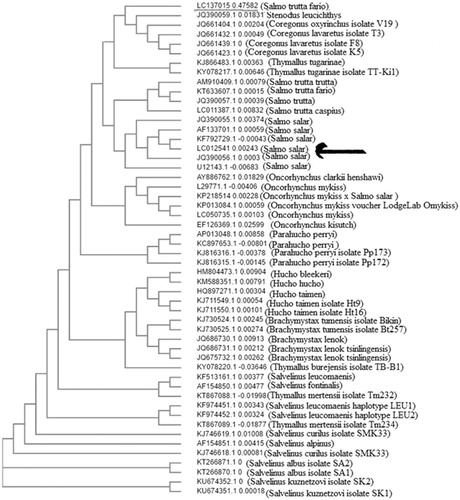Abstract
The mitochondrial genomic of Atlantic salmon (Salmo salar) was sequenced and deposited in GenBank accession no. LC012541.1. In this study for the evolutionary analysis of Mtgenomic between S. salar and other salmonid species such as S. t. fario, S.t. trutta and S.t. caspius were conducted by using MEGA Software Version 7. The results showed that there is a major homology between S. salar and other salmonids like S.t. fario and S.t. trutta, and we can see it in showing the close relationship between them.
Salmonidae species only have one family in the name of salmonids including 70 species. The Atlantic salmon (Salmo salar) is a species of the ray-finned fish in the family Salmonidae. It is found in the northern Atlantic Ocean and rivers flowing into the north Atlantic in the North Pacific Ocean. Several studies have been performed to find out the relationship between phenotypic traits of salmonid species (Salmo trutta lacustris and Salvenilus alpines (Pakkasmaa and Piiorenen Citation2001) Salmo trutta (Oadri Citation1959; Blanc et al. Citation1982)
Salmo trutta caspius (Rezaei et al. Citation2017) salmon species, which were collected from winter to summer in 2015, were three years old.
The total genomic DNA extracted from tissue taken from fresh specimens that was stored in −20 °C in the refrigerator from Marine Biology of Laboratory for Ecology and Systematic in Islamic Azad University Tonekabon Branch, Tonekabon-Iran. The DNA isolation was carried out using the phenol–chloroform protocol (Sambrook and Russel Citation2001). After conducting the PCR technique, the universal primers were designed; thereby the PCR product was carried out for sequencing. Mtgenomic in S. salar was deposited in GenBank accession no. LC012541.1.
The evolutionary analyses were conducted by using MEGA Software Version 7 (Tamura and Nei Citation1993). The analysis involved 50 nucleotide sequences. There were 16,622 positions in the final dataset. The results showed that there is a major homology between S. salar and other salmonids like S.t. fario and S.t. trutta. They are shown in , and it shows the close relationship between them.
Disclosure statement
We had no conflicting interests influencing the paper.
Additional information
Funding
References
- Blanc JM, Poisson H, Vibert R. 1982. Variabilité gé né tique de la ponctuation noire sur la truitelle Fario (Salmo trutta L.). Ann Genet Sel Anim. 14:225–236.
- Nei M. 1987. Molecular evolutionary genetics. New York (NY): Columbia Univ. Press.
- Oadri S. 1959. Some morphological differences between the subspecies of cutthroat trout, Salmo clarkii clarkia and Salmo clarki lewisi in British Columbia. J Fish Res Board Can. 16:903–922.
- Pakkasmaa S, Piiorenen J. 2001. Morphological differentiation among local trout (Salmo trutta) populations. Biol J Linn Soc. 72:231–239.
- Rezaei A, Akhshabi SH, Jamalzadeh HR. 2017. Studies on the mitochondrial genomics in Salmo trutta caspius population in three Rivers of South Caspian Sea. Res J Biotechnol. 12:4.49–61.
- Sambrook J, Russel DW. 2001. Molecular cloning: a laboratory manual. Cold Spring Harbor (NY): CSH Laboratory Press.
- Tamura K, Nei M. 1993. Estimation of the number of nucleotide substitutions in the control region of mitochondrial DNA in humans and chimpanzees. Mol Biol Evol. 10:512–526.

